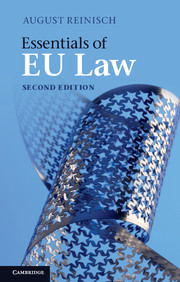Book contents
- Frontmatter
- Contents
- Preface
- Abbreviations
- 1 History of European integration
- 2 The institutional framework
- 3 The making of Union law
- 4 The effect of Union law
- 5 Judicial control within the Union
- 6 Protecting fundamental rights within the EU
- 7 The free movement of goods
- 8 The free movement of persons
- 9 EU competition law
- 10 Selected EU policies
- 11 The EU as an international actor
- Index
7 - The free movement of goods
Published online by Cambridge University Press: 05 November 2012
- Frontmatter
- Contents
- Preface
- Abbreviations
- 1 History of European integration
- 2 The institutional framework
- 3 The making of Union law
- 4 The effect of Union law
- 5 Judicial control within the Union
- 6 Protecting fundamental rights within the EU
- 7 The free movement of goods
- 8 The free movement of persons
- 9 EU competition law
- 10 Selected EU policies
- 11 The EU as an international actor
- Index
Summary
Gradually establishing the free movement of goods, one of the four freedoms of the internal market, was one of the centre-pieces of early market integration in the EEC. This was pursued by internal and external measures. Already Article 9(1) of the original 1957 EEC Treaty (now Article 28(1) TFEU, ex Article 23(1) TEC) provided for the gradual establishment of a customs union between the Member States and a common customs tariff vis-à-vis third countries.
Internally, a customs union requires the elimination of customs duties and ‘charges having equivalent effect’ (Article 30 TFEU, ex Article 25 TEC) as well as of discriminatory or protectionist internal taxes (Article 110 TFEU, ex Article 90 TEC), plus the elimination of quantitative restrictions on imports and exports and ‘measures having equivalent effect’ (Article 34 and 35 TFEU, ex Articles 28 and 29 TEC).
Externally, the Common Customs Tariff is fixed by EU legislation in the form of Council regulations, which have been regularly updated since 1968. The Common Customs Tariff forms part of the Community’s exclusive powers in the field of the Common Commercial Policy.
However, the establishment of a true internal market for goods freely circulating within the entire area of the EU was not only a ‘legislative’ task, pursued by rule-making through treaty norms as well as secondary legislation in the form of harmonisation directives and regulations. To a large extent, the common market is the ‘product’ of the ECJ. The Court has pushed forward market integration in a line of landmark cases, such as Dassonville and Cassis de Dijon , in which it broadly interpreted the Treaty notion of ‘measures having equivalent effect’, and deduced a duty of ‘mutual recognition’ of goods lawfully produced and marketed in any of the Member States of the EU. The combined effect of these and subsequent ECJ cases has been a considerable limitation of the power of Member States to maintain rules which could exclude the goods of other Member States from their national markets. However, the Court has not been insensitive to criticism from the national level and proved in cases such as Keck that it was willing to restore, at least to some extent, the autonomous rule-making power of Member States.
- Type
- Chapter
- Information
- Essentials of EU Law , pp. 121 - 138Publisher: Cambridge University PressPrint publication year: 2012



